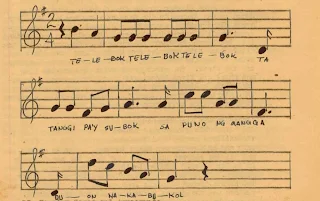Tuy, Batangas: Historical Data Part Part V
PART V
PART I | PART II | PART III | PART IV | PART V | PART VI
[p. 15]
2. A person should not take a bath on days when the moon is on its last quarter for it may happen that he may get sick.
3. Taking a bath on Good Friday is not good.
2. One shall not leave if there is someone dead in the house or in the neighborhood.
3. One shall not leave while eating in the house is not finished yet.
2. In order that the pig may keep on staying in a fixed place, the first vowel removed must be buried under the stairway.
2. In dressing up the corpse, if the person dressing happens to feel that the corpse is soft, it means that another member of the family would soon follow.
3. Prior to the interment, the dirty plates must not be placed on top of the other, otherwise death shall be frequent in the family.
4. Before the eighth day, the family is restrained from eating vegetables of the vine family to prevent frequent deaths in the family.
[p. 16]
Popular Songs, Games and Amusements
I. Popular Songs
Ang babae sa lansangan, kung gumiri’y parang tandang.
Ang anak ni Tandang Liloy
Masama ang amoy.
Sa puno ng mangga
Duon nakatumbak.
Talaga ng Dios, tinutok ng ibon,
Nalaglag sa puno, sa dulo gumulong.
AKO AY NAGTANIM
[p. 17]
II. Popular Songs, Games, and Amusements[p. 18]
Mga Bugtong at Palaisipan
1. Alin dito sa mundo malaki pa ang mata sa ulo? (tutubing)
2. Isang mahabang mabilog, kwarto-kwarto ang loob. (kawayan)
3. Hindi tao, hindi pari, nagsusuot ng sari-sari. (sampayan)
4. Isang bi-as na kawayan, punong-puno ng kamatayan. (baril)
5. Bumili ako ng alipin, mataas pa sa akin. (sumbrero)
6. Buhok ng pari, hindi mawahi. (tubig)
7. Maraming mata nguni’t hindi nakakakita. (pinya)
8. Kung gabi ay dagat, kung araw ay bumbong. (banig)
9. Mayroong limang tao na naglalakad. Ang isa ay bunot ang espada at ang apat ay wala. Sila ay napalaban. Bakit hindi lumabas ang taong may dalang bunot na espada? (Ang espada ay “bunot” ng niyog.)
10. Manok kong puti, maghapon sa baliti [balete], nagpakitang giri. (araw)
11. Baboy ko sa kaingin, nataba’y walang pakain. (kamote)
12. Sibat ni Adan, hindi mabilang. (ulan)
13. Nagtago si Pedro, labas ang ulo. (pako)
14. Lingus-lingusin, hindi abutin. (taynga)
15. Sarsang hindi mapagsawsawan, parilyang hindi mapaglutuan. (sarsaparilya)
16. Tatlong magkakapatid matatag sa init. (tungko)
17. Wala sa langit, wala sa lupa, dumadahon ng sariwa. (dapo)
18. Alisto ka pandak, papatungan ka ng mabigat. (dikin)
19. Tubig sa ining-ining, hindi mahipan ng hangin. (tubig ng niyog)
20. Alin dito sa mundo, nalakad ng walang ulo. (katang)
[p. 19]
21. Dalawang magkumpari, mauna’t mahuli. (paa)
22. Masama ang ngalan, masarap ang laman (baboy)
23. Malayo pa ang sibat, nganga na ang sugat. (bibig)
24. Nanganak ang birhen, nanlaglag ang lampin. (puno ng saging)
25. Kung bago ay mahuna, matibay kung saluma. (pilapil)
26. Kalabaw ko sa Maynila, abot dito ang unga. (ugong)
27. Isang biging palay, sikip sa buong bahay. (ilaw)
28. Magtag-ulan at magtag-init, hanggang tuhod ang bayakis. (manok)
29. Nanganak si Adan, sa tuktok nagdaan. (saging)
30. Trak ng pari, nagpauli-uli. (duyan)
31. Isang bayabas, pito ang butas. (ulo)
32. Umiiyak walang mata, natindig walang paa. (kandila)
33. Namunga muna bago namulaklak. [blurred]
34. Binuksan ko ang bintana, ang sundalo ay naghiga. (posporo)
35. Nang hawak ko ay patay, nang ihagis ko ay nabuhay. (trumpo)
36. Baston ng kapitan, hindi mahawak-hawakan. (ahas)
37. Nang maglihi’y namatay, nang manganak ay nabuhay. (siniguelas)
38. Naibigan pa ang basag kay sa buo’t walang lamat. (kamatsili)
39. Nagtanim ako ng dayap sa gitna ng dagat, iisa ang nagkapalad. (dalaga)
40. Alin ang masarap sa manok? (mais)
41. Bakit natin isinasara ang durungawan kung gabi? (pagka’t nakabukas)
42. Dalawang tindahan, sabay buksan. (mata)
43. Bahay ni kaka, hindi matingala. (nuo)
44. Kamay ng Kastila, punong-puno ng ligata. (pipino)
45. Mag-asawang magsingliyag araw-gabi, magkaharap kaya hindi magkalapat nasasaalaala [uncertain word, blurred] ang anak. (hagdan)
46. Bahay ni kumari, iisa ang haligi. (payong)
47. Mayroong mag-ama. Anong pangalan ng ama? (anong)
48. Tinting na uling nabibitin, puwera duhat nakakain. (kalumpit)
49. Walang puno, walang ugat, humihitik ang bulaklak. (bituin)
50. Hindi Linggo. Hindi pista. Nagladlad ang bandera. (dahon)
Proverbs and Sayings
1. The young crab crawls in the same way as its elders.PART I | PART II | PART III | PART IV | PART V | PART VI



